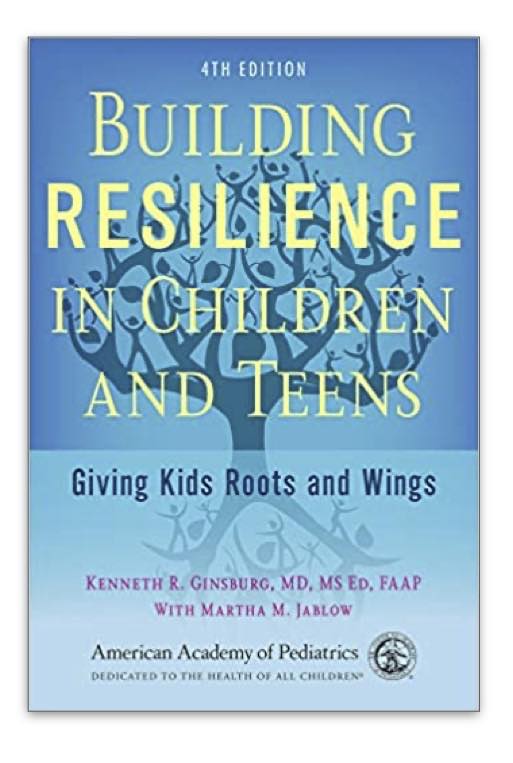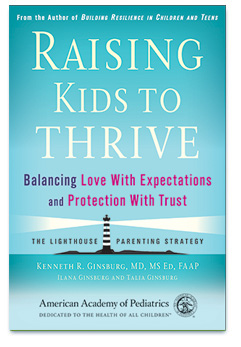
Building Resilience in Children and Teens
|
Building Resilience in Children and Teens offers strategies to help young people from 18 months to 18 years build seven crucial “Cs” — competence, confidence, connection, character, contribution, coping, and control — so they can bounce back from challenges and thrive throughout life. The book describes how to raise authentically successful children who will be happy, hardworking, compassionate, creative, and innovative. Dr. Ginsburg reminds parents that our goal is to think in the present and prepare for the future, to remember that our real goal is to raise children to be successful 35-year-olds. It’s about more than immediate smiles or even good grades; it’s about raising kids to be emotionally and socially intelligent, to be able to recover from disappointment and forge ahead throughout their lives. The stable connection between caring adults and children is the key to the security that allows kids to creatively master challenges and reach their highest potential. This book offers concrete strategies to solidify those vital family connections. Resilience is also about confronting the overwhelming stress that kids face today. This invaluable guide offers coping strategies for facing the stresses of academic performance, high achievement standards, media messages, peer pressure, and family tension. Young people too commonly survive stress by indulging in unhealthy behaviors or by giving up completely. The strategies offered here are aimed at building a repertoire of positive coping skills. Young people who have these healthy strategies in place may be less likely to turn to those quick, easy, but dangerous fixes that adults fear. The book includes detailed strategies to guide children and teens to create their own customized positive coping strategies. The fourth edition of this already acclaimed book is updated throughout and offers deeper dives into building grit in our children, offering meaningful protection against the effects of childhood trauma, and preparing our families for lifelong interdependence. It also guides parents on how to turn for professional help when needed, reconnect with children who have pulled away from them, and help young people return to their best selves after they have engaged in worrisome behaviors. It also offers strategies for parents to recharge and rebound when their own resilience reaches its limits. |
Congrats - You're Having a Teen!
|
Congrats? The word “congratulations” is not usually associated with parenting teenagers. Honestly, have you learned to expect “survival guides” to the teen years? Reflect on that for a moment. Your expectations of adolescents may have already been negatively flavored. A distorted view of adolescence as a time of storm and stress, trouble, and turmoil fills parents with foreboding. In turn, your adolescent is sensitive to the unspoken signals you send when you fear their growth. Too many adolescents quickly learn that their stage of life is worthy of an eye roll and, worse yet, that they are disappointing their parents just by growing—a process they couldn’t stop if they wanted to. This book is part of a movement that will create a different world for teens—one family at a time. It is unabashedly pro-teenager and unashamedly pro-parent. It positions you to be the essential guide your teen needs to make the most of this age of astounding opportunity and unrivaled growth. It celebrates adolescence but is not naive about the challenges the teen years sometimes bring to caregivers and young people alike. This book is a toolkit that will empower you with the communication skills to bring out the best in your teen, and to strengthen your relationship. It will also prepare you with the strategies you’ll need to bring your child back to being their best self if they do go astray. It is solidly committed to the notion that the best way to address a problem is to build on a strength. In This Book You'll Learn...
In This Book You'll Take a JourneyThis book takes you on a journey just as you will accompany your child on their trek into adulthood. Your teen needs you now as much as they ever did. Earlier in their life, they relied on you for their very survival…now they rely on you to shape them into an adult who will lead us into the future. They’ll be ready when they trust your unconditional presence. #standbyteens. |
Raising Kids to Thrive
|
“I like to think of myself as a lighthouse parent, you know reliably there, totally trustworthy, making sure he doesn’t crash against the rocks, but committed to letting him learn to ride the waves.” Two fundamental principles are at the root of resilience. First, a parent’s unconditional love is the most important force in a child’s life. It offers the unwavering security that helps young people develop the confidence to walk through life’s puddles. Unconditional love has to be coupled with high expectations for effort, character and morality. Otherwise, a child will feel nurtured, but not learn to hold himself to high standards. Second, a child will never learn life’s lessons if he is protected from experiencing them. This point has to be tempered with the fact that children need protection from challenges that can bring irreparable harm. These fundamental principles are anything but simple. The challenge of parenting is how to apply these core principles in a complicated world. It doesn’t matter what we know to be right, what we wrestle with is how to do it. There are two questions with which we struggle as we consider how to build resilience in our children.
This book helps you resolve the tension these two principles of resilience pose by offering you the latest in research and a wide breadth of expert opinion. You will learn to balance these complex issues and offer your child the security she can only gain from you and the confidence she can only develop from experience. She will be more than resilient – she will be poised to thrive. This book is groundbreaking because it offers detailed input from teens!Over 500 young people from all over our nation offer their insights into what they need from their parents in order to be prepared to thrive. These young people may not have the wisdom of years, but they are very close to parenting and know what approaches are most effective for them and which backfire. Ideally, your own children would have the kind of open conversations that would allow growth in your relationships and better guide you how to parent them. That idealized reality does not always exist. This book will allow you to listen objectively to teens’ views so you can better understand your own child’s needs. The book concludes with a comprehensive section on how to foster optimal communication within your own family. |











